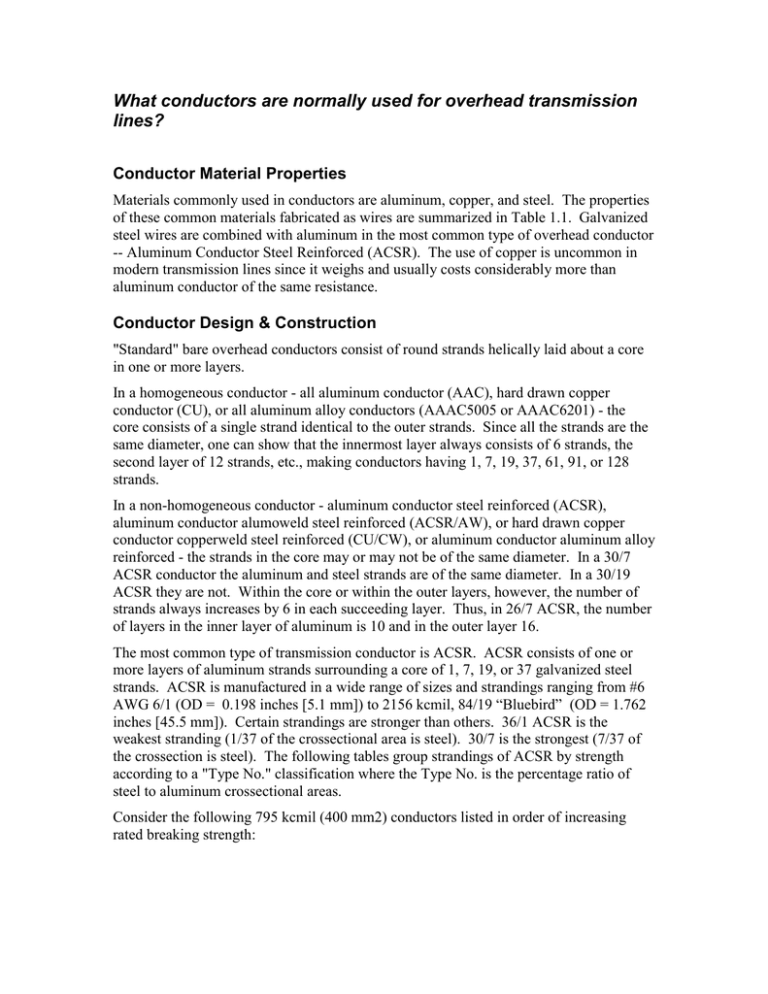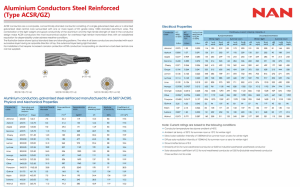What conductors are normally used for overhead transmission lines?
advertisement

What conductors are normally used for overhead transmission lines? Conductor Material Properties Materials commonly used in conductors are aluminum, copper, and steel. The properties of these common materials fabricated as wires are summarized in Table 1.1. Galvanized steel wires are combined with aluminum in the most common type of overhead conductor -- Aluminum Conductor Steel Reinforced (ACSR). The use of copper is uncommon in modern transmission lines since it weighs and usually costs considerably more than aluminum conductor of the same resistance. Conductor Design & Construction "Standard" bare overhead conductors consist of round strands helically laid about a core in one or more layers. In a homogeneous conductor - all aluminum conductor (AAC), hard drawn copper conductor (CU), or all aluminum alloy conductors (AAAC5005 or AAAC6201) - the core consists of a single strand identical to the outer strands. Since all the strands are the same diameter, one can show that the innermost layer always consists of 6 strands, the second layer of 12 strands, etc., making conductors having 1, 7, 19, 37, 61, 91, or 128 strands. In a non-homogeneous conductor - aluminum conductor steel reinforced (ACSR), aluminum conductor alumoweld steel reinforced (ACSR/AW), or hard drawn copper conductor copperweld steel reinforced (CU/CW), or aluminum conductor aluminum alloy reinforced - the strands in the core may or may not be of the same diameter. In a 30/7 ACSR conductor the aluminum and steel strands are of the same diameter. In a 30/19 ACSR they are not. Within the core or within the outer layers, however, the number of strands always increases by 6 in each succeeding layer. Thus, in 26/7 ACSR, the number of layers in the inner layer of aluminum is 10 and in the outer layer 16. The most common type of transmission conductor is ACSR. ACSR consists of one or more layers of aluminum strands surrounding a core of 1, 7, 19, or 37 galvanized steel strands. ACSR is manufactured in a wide range of sizes and strandings ranging from #6 AWG 6/1 (OD = 0.198 inches [5.1 mm]) to 2156 kcmil, 84/19 “Bluebird” (OD = 1.762 inches [45.5 mm]). Certain strandings are stronger than others. 36/1 ACSR is the weakest stranding (1/37 of the crossectional area is steel). 30/7 is the strongest (7/37 of the crossection is steel). The following tables group strandings of ACSR by strength according to a "Type No." classification where the Type No. is the percentage ratio of steel to aluminum crossectional areas. Consider the following 795 kcmil (400 mm2) conductors listed in order of increasing rated breaking strength: Comparison of mechanical properties for different strandings of 795 kcmil ACSR conductors (US Common Units). Type No. Code Name No. x OD[in] Alum Wire Steel Wire No. x OD[in] Overall Diameter [in] Rated Strength [lbs] 0 3 7 10 16 23 Arbutus Coot Turbot Puffin Drake Skimmer 37 x 0.1466 36 x 0.1488 20 x 0.1994 22 x 0.1901 26 x 0.1749 30 x 0.1628 None 1 x 0.1488 7 x 0.0886 7 x 0.1056 7 x 0.1360 7 x 0.1628 1.026 1.040 1.063 1.077 1.108 1.140 13,900 16,800 21,800 24,800 31,500 38,300 Total Weight [lbs/Kft ] 746 805 896 958 1094 1246 Core Weight [lbs/Kft ] 0 59 150 212 344 483 Comparison of mechanical properties for different strandings of 400mm2 ACSR conductors (SI Units). Type No. Code Name 0 3 7 10 16 23 Arbutus Coot Turbot Puffin Drake Skimmer Alum Wire No. x OD[mm] 37 x 3.724 36 x 3.780 20 x 5.065 22 x 4.829 26 x 4.442 30 x 4.135 Steel Wire No. x OD[mm] None 1 x 3.780 7 x 2.250 7 x 2.682 7 x 3.454 7 x 4.135 Overall Diameter [mm] 26.1 26.4 27.0 27.4 28.1 29.0 Rated Strength [N] 61 800 74 700 97 000 110 300 140 100 170 400 Total Weight [N/km] 10 890 11 750 13 080 13 980 15 960 18 180 Core Weight [N/km] 0 860 2 190 3 090 5 020 7 050 The stronger the ACSR conductor is, the higher the conductor tension under all conditions, and the less the conductor stretches under load (thus reducing sag increase for a given ice and wind loading). High strength strandings of ACSR also exhibit less thermal elongation and less high temperature creep so it is likely that the sag increase under high temperature conditions will be less. The major drawbacks to high strength ACSR are cost (a 30/7 ACSR conductor costs about 30% more than an all aluminum conductor of the same kcmil area), increased angle structure tension loads, and, under certain conditions, increased aeolian vibration induced fatigue of the aluminum strands.
